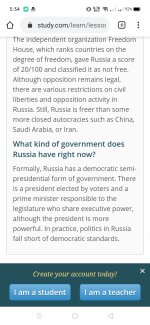OoohhhhMyyyySauuuce
Addict
Please enlighten me, nalilito po ako.
Nabasa ko po iisang website,
Ang russia daw po ay federal semi-presidential form of government, tapos nabasa ko sa pinakadulo ang sabi, russia has a democratic semi-presidential form of government,
Paki explain nga po kung same lang po yan? At paano po nagwowork ang ganyang government?
Nabasa ko po iisang website,
Ang russia daw po ay federal semi-presidential form of government, tapos nabasa ko sa pinakadulo ang sabi, russia has a democratic semi-presidential form of government,
Paki explain nga po kung same lang po yan? At paano po nagwowork ang ganyang government?
